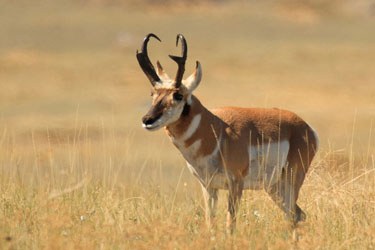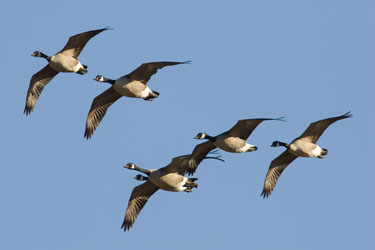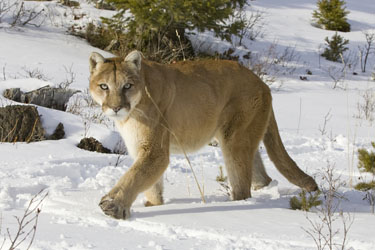Please check back frequently to get the latest Hunt Specials from Alberta Outfitters on HuntAlberta.ca. If you want to be informed on future Hunt Specials please provide your contact details:
Alberta offers Bighorn Sheep, Elk, Moose, Mule Deer, Whitetail, Antelope, Bird Game, Black Bear, Cougar, Coyote & Wolf hunts. For more information on hunting opportunities in Alberta please read the following article.
Spotlight on Alberta
From mountains to prairies, Alberta nurtures healthy numbers of some of this continent's greatest game - and it invites hunters to accept the challenge!
The province of Alberta was named for a princess, the daughter of Queen Victoria. Just like a royal lady, she contains areas of great beauty and her good looks mantle a heart of gold. She has a handbag full of surprises and a sunny disposition, but please never cross her. Even a lady can have her moods.
Her hunting tradition is long and venerable. The fur trade started opening the west and north, for Alberta extends to both of those extremes. Then came the pioneers and the cattlemen of the 1800's, remembered in the famous Calgary Stampede and the Edmonton Klondike days. The historic past still live in the names of the early forts like Macleod, McMurray, and Vermillion. Many tribes of Indians live on reservations established in these early days.
Men of vision set aside large national parks in recognition of the singular and unique beauty of the Rocky Mountain front ranges. Waterton, Banff, Jasper continue to attract worldwide visitors to their awesome beauty. Alberta's front ranges are different from the mountains to the west in British Columbia. The Rockies get snow, but never too much. The valleys are verdant, but they retain plenty of the exposure and grassy areas so necessary for game. Timber is sturdy, but not so desirable as to inflame man's greed for same.
These mountains contain all the usual mountain game - sheep, goats, cougar, and elk. But, much like Montana, in Alberta there are also great plains and prairies containing lots of cactus, rattlesnakes, and antelope that stretch eastward from the mountains.
Large parkland regions are rich with dark soil and grain fields that skirt pothole ponds and aspen stands. These are ideal for such game as mule deer, whitetail, geese and ducks. The remaining majority of Alberta's 280,000 square-mile area is northern bush, and it serves as home to moose, wild buffalo, bears, and wilderness lakes forming a vast waterfowl hatchery. The variety of geography means diversity in habitat and a host of different species.
Perhaps most important of all, Alberta game lives in a land of climatic conditions ranging between extremes. At the 49th Parallel, the summer sun bakes the prairie grass and cactus to near-desert conditions. Yet the northern fringe of bush contains areas verging on permafrost. The winters can be bitterly cold, but occasional Chinook winds blow warmth and life onto the land.
Alberta game must be robust to take these conditions, and the consequent results have been genetic superiority. For the hunter, this means that Alberta produce an extraordinary number of exceptional trophies, despite the rather modest populations of most big game.
Of course, you cannot maintain quality without first-class wildlife management. Over the past decade, Albertans have taken steps to nurture their wonderful resources. Changes have been instituted to balance the needs of all the diverse interests that impact wildlife. Limited area draws now provide quality hunting in areas where overharvest had been a symptom of easy access. Other regions have been set aside as pure wilderness for traditional packtrain hunting.
Many of Alberta's wildlife management policies are continually discussed and negotiated between three organizations (Government via Sustainable Resource Development, Resident Hunters via the Alberta Fish and Game Association, Non-Residents and their Outfitters via the Alberta Professional Outfitter Society). Government, hunters and outfitters alike point with pride to the outfitter policy that has provided standards and bonding requirements to enhance the long-standing professionalism in the overall non-resident hunting industry in Alberta. At times the three groups may disagree on the best path to move forward on individual issues. Yet despite storm clouds of change and controversy, and perhaps in keeping with Alberta's vast distances and differences, she remains overall a wonderful place to hunt.
Bighorn Sheep

Bighorn sheep were the premier trophy during the halcyon days of outfitting. Packtrains of wealthy sheep hunters once combed the Rockies in search of the great rams. The legendary Jack O'Connor took his best bighorn there back in the 1940's. Alberta still attracts those seeking the finest in wilderness sheep hunting.
On an outfitted hunt, a non-resident took a ram scoring well over 190 points on a mountain overlooking the Smoky River and less than a day's ride from O'Connors's old stomping grounds. Sheep hunting season runs in September and October when the mountains are most beautiful. Nonresidents; success is nearly 50 percent most years, and Alberta bighorn hunts command top dollar. Only rams with 4/5 curl or better are legal.
A unique opportunity awaits the adventurous bowhunter who reserves a hunt in the highly sought after areas that have limited hunt opportunities. It is perhaps the best option in North America to take late-fall hunt while the rams are ewes in preparation for the rut. One great ram scoring over 200 points was twice missed by a non-resident hunter and finally met an untimely demise while crossing the highway that transects the zone just a few years ago. Well-know bowhunter Chuck Adams scored on a tremendous broomed ram in this zone.
Elk

Elk herds in Alberta are spread throughout the province however non-residents are limited to hunt elk in the foothills and mountain areas. Estimates suggest 16,000 elk occupy the mountain fringe. There were fewer than 2,000 harvested each fall in recent years. Just as with other Alberta game, the low harvest statistics belie the great quality of some of the elk taken. The present fourth and seventh largest elk ever taken were harvested in the 1970's in Alberta on the Panther and Muddywater rivers. Some giant bulls continue to be taken each year in the province.
Elk hunts are for the most part conducted by outfitters using packtrain style trips onto public lands. Only a small amount of quality trophy hunting is available on private lands in Alberta.
Moose

Large areas of northern Alberta harbor untouched populations of Canada moose. In recent years seismic companies have crisscrossed every square mile of the northern bush with trails. However, in spite of increased access, there are trophy-class bulls still available to moose hunters in the vast areas of northern bush and the slopes of the Canadian Rockies. A limited opportunity is available for the smaller mountain moose, which is classified by the Safari Club as a Shiras moose in southern Alberta. Boone and Crockett does not recognize these as the Shiras subspecies.
Mule Deer

Mule deer hunting has always drawn great interest from hunters ever since the world record non-typical was harvested in 1926. Over the last 15 years the government has implemented a controlled draw system to control the numbers and quality of deer. Prior the draw system, the problem has been overhunting and the mule deer buck's natural vulnerability to pressure.
The draw system was originally implemented in southern Alberta mainly the prairie and some of the foothills zones. Most of the mule deer country in these areas is mixed between private land owners and grazing leases which ensures access to some hunting areas but also ensures that there are sanctuaries. These improvements to licensing practices are once again allowing bucks to grow old. There are plenty of solid four-by-four heads now available and the genetics are getting better each year.
Over the last few years, the government has extended the draw system into central Alberta mainly in the foothills and mountain zones. Many hunters are already experiencing improved quality. Outfitters and non-resident hunters both know the high quality potential and with further improvements, Alberta will continue to be the destination for world class mule deer.
Whitetail Deer

Alberta's whitetail were scarcely touched until the late 1970's. Nobody paid much attention to them until the whitetail craze in the 1980's, when an industry was born. Outfitters started catering to that newfound interest, and record-book heads started coming out of the woodwork.
In the past, first-time Alberta hunters were either ecstatic or disappointed depending what they saw during their hunt. Part of the problem was expectations. You may not see very many deer on the typical whitetail hunt, but if you do spot a buck look out - he may be a hummer.
For many hunters, patience is required in order to take advantage of the Alberta style of hunting deer. Whitetail Deer numbers dictate the hunting style best used in each hunting area. A big, old 300-pound buck may cover 10 miles a night with ease during the November rut. Hunters typically follow tracks in the snow and push-bush to jump the deer from daytime lairs. For many it was too fast, too noisy, and too difficult to hit the running deer pushed by the drivers. Yet hunters kept returning for chances at quality racks. Estimates are that over two dozen Boone and Crockett qualifiers are taken each year.
Whitetail deer are the focus of many outfitters in Alberta, despite the fact that the outfitting industry for whitetails is under 30 years old. Rapid exploitation of the game of non-resident hunters lead in part to the formation of Alberta's outfitting policy. While the bush-pushing technique remains productive, outfitters today are likely to use the full gamut of whitetail hunting techniques: stand-hunting, spot-and-stalk, rattling, calling, and, of course, still-hunting and tracking.
Antelope

Pronghorn antelope have been open to the nonresident alien hunter in Alberta for just over 20 years. Prior to that, they were restricted to Canadian hunters. The antelope in Alberta fluctuate in population and are at the fringe of their habitat here on the northern Great Plains. However, there are an inordinate number of very respectable trophies taken each year. In fact, it is a sure bet that the average antelope taken in Alberta is much better than the average taken in areas with greater antelope notoriety. Record-book bucks are taken each year, and some of the outfitters are enthusiastic about the new opportunities for nonresidents.
Black Bear

Black bears love honey, and Alberta has lots of it. But local farmers have never been pleased with the numbers of bears and the well-known ursine sweet tooth. At one time hundreds of bears were either trapped or shot by farmers and wildlife officials in an attempt to eradicate beehive damage. Over the past decade wildlife officials have directed management efforts toward increasing the bear harvest.
There is a two-bear limit in both the spring and fall, and many zones are open to baiting as well. Local hunters generally cruise the oat fields where the bears love to munch of fresh grain, or they visit honey-hive locations or float the bank of rivers seeking bruins feeding on tender spring grasses. A favorite time to hunt is just before the "buds pop". This refers to the early spring budding on aspen trees. Bears love to eat the sappy buds and are easily spotted in the trees.
Alberta's bears come in a great range of color phases. Honey blondes and cinnamons are taken up to 30 percent of the time and make a very unique and beautiful black bear trophy.
Approximately 1,500 or more black bears are taken every year, and the recent development of a viable black bear outfitting industry has resulted in many large bear skulls returned for official scoring.
Bird Game

Hunting upland species and waterfowl has always been a real mixed-bag affair. It is not uncommon on a prairie shoot to take mallards and pintails. Canada, whitefronted, or Ross geese and fill out the day with some Hungarian partridge, sharp-tailed grouse, or pheasants.
Goose hunting is presently the best waterfowl opportunity in Alberta. But pockets of good duck hunting still exist in the Peace River country and other select areas where water is still available in the potholes. Some of Alberta's best duck hunting regions have been lost to the drought and diminished duck populations.
Hungarian partridge are probably the most common upland species since vast grain fields on the dry prairies ale ideal habitat. Pheasants have suffered from the drought and channelization projects that reduced habitat along irrigation canals in southern Alberta. The best shooting is still found near Brooks.
The dedicated bird hunter can still find plenty of sharptails and even more ruffed grouse. Ruffies, to whom the monicker "fool hen" has always stuck, are hardly hunted by residents. Spruce grouse, blue grouse, and ptarmigan can be found by any hunter who desires those species. Small game, like rabbits or hares, are rarely hunted by the average Albertan, but are available to whoever wants them.
Of interest to some game bird hunters will be the combination hunts that some outfitters offers: Part of the week is spent chasing birds, other days entail stalking the browns and rainbows of the world famous Bow River.
Only a few Alberta outfitters cater to bird hunters, as nonresidents aren't required to use guides for upland game or waterfowl. All that is needed are the requisite licenses and a spirit for discovery. Alberta landowners appreciate hunters asking permission. Many farm and ranch lands remain unposted. Nonresidents with a smile and a good attitude will find plenty of country to hunt, especially if they venture a good hour's drive or more from the city.
Cougar

Mountain lion (Cougar) opportunities are available on a limited basis to nonresidents and residents alike. Biologists advise that the Alberta lions are genetically comparable to the best from anywhere.
Wolves and Coyotes

Carnivores such as wolves and coyotes are at very high levels following a decade of good winters and high prey levels. The best time to hunt wolves is during the winter however many hunters add both wolf and coyote tags to their big game hunts in the fall.
Written by Ken Nowicki